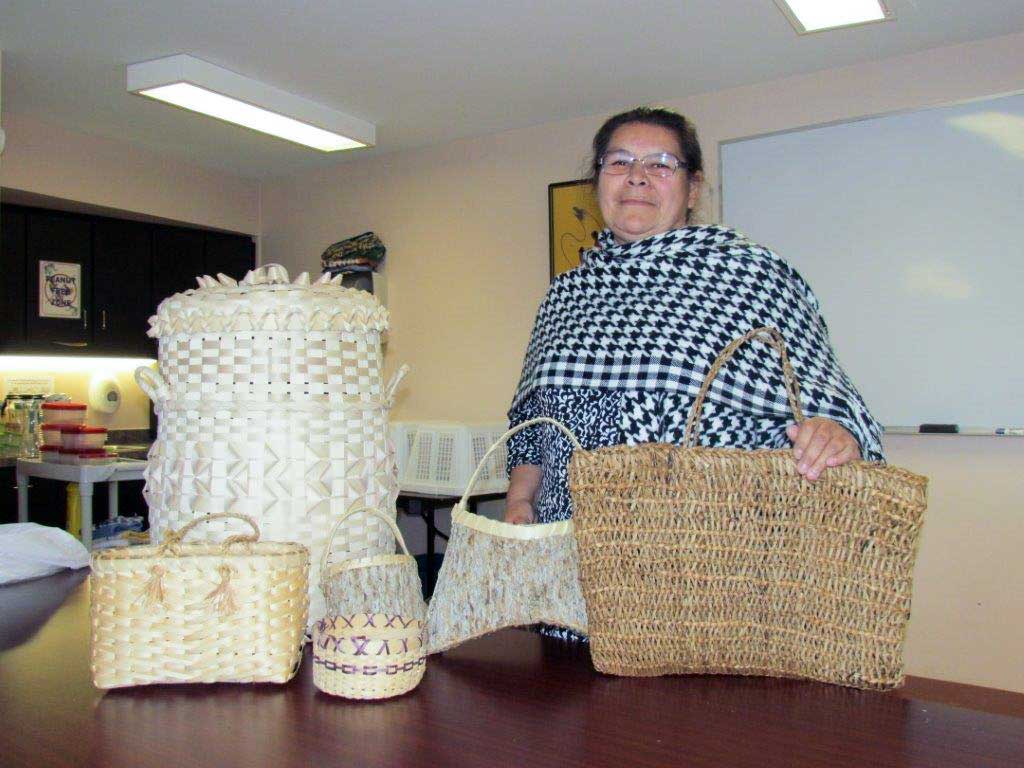by Betty Bardswich
M’CHIGEENG—First Nation people having been making baskets for everyday use for hundreds of years. Here on Manitoulin, Dora Bebamash of M’Chigeeng has been keeping the tradition alive through a lot of hard work and a love of the process.
Preparation for the practice begins with the selection of a good black ash tree. Ms. Bebamash was accompanied on this journey with Gene Bebamash, Bert Panamick, Archie Panamick, Bonita Bebamash and a resident of the M’Chigeeng Wellness Centre.
“We harvest the tree in the spring,” Ms. Bebamash explained, “as the bark lets go easily as the sap runs up the tree. This makes it easy to peel the bark and to make black ash bark baskets for berries. We scout for a good tree about a month before we start the baskets. We probably looked at eight or nine trees over a couple of days to find the right one. We look for the tree, fairly straight and without a lot of knots or branches. If we find one that looks suitable, we take a wedge out of it to see the rings. The thickness of the growth rings should be about the thickness of a quarter or nickel. If they are too thick, they are not easy to work with. If the thickness is too thin, that is not ideal either. Black ash grows in swampy areas. The tree we chose was on an elders property and we asked him for permission to take the tree. He said yes when we explained what we wanted it for.”
In keeping with Anishinaabe culture and tradition, Ms. Bebamash offered thanks to the tree and left semma (tobacco) as a thank you. “You explain to the tree what you are going to do with it,” she added. The group also gave semma to the elder as a thank you and in addition gave a beef loin cut up and packaged in smaller pieces for him.
After the tree is cut down and brought back to Ms. Bebamash’s home, the real work begins. “You peel the bark off and then you pound the tree,” she said, “and the tree must be pounded over every inch with the blunt edge of an axe, otherwise it cannot be split. Processing is 75 percent of the work. Pounding the tree separates the growth rings. We got four sticks out of this tree and it can take up to 15 hours to pound one stick.” Pounding the six foot stick with every part of it touched is hard work and is done to cause thick splints to separate at the annual growth rings. Once the splints are removed from the tree, they are split again to create two splints which are shaved to make them smooth and then used for weaving.
Ms. Bebamash learned basket weaving from Renee Wasson Dillard who resides in Michigan and received that state’s Heritage Award in 2010. She is an artist and educator who seeks to keep the aboriginal culture alive and was invited by Alan Corbiere, who was then the executive director of the Ojibwe Cultural Foundation, to come to M’Chigeeng. Ms. Dillard is also a natural fibre weaver and teaches that art as well.
Ms. Bebamash spent the winter weaving along with Andrea McGraw and Bonita Bebamash and noted that weaving can be done with bulrushes, milkweed and bass wood as well as black ash. “Bass wood cordage,” she noted, “makes handles that are stronger than any rope you can buy.” Ms. Bebamash also commented that there is a lot of process when you are working with natural elements, but one can see the love she has for this artwork as the baskets she has made include a hamper which took 35 hours to finish from the splints as well as bark baskets with drawings inside and natural fibre baskets. Ms. Bebamash also keeps busy, along with her sister Bonita, making star quilts for members of her family.
To purchase woven baskets visit Ojibwa Cultural Foundation Open Air Market every Thursday.
There is a sober side to consider regarding not only the making of black ash baskets, but most importantly to the health of our forests and community plantings. The emerald ash borer attacks and kills every type of ash tree and is spreading across the country, including Ontario. According to Ontario’s Invading Species Awareness Program, this pest, native to Asia, has killed millions of trees in southwestern Ontario and the Great Lakes states. As its name implies, the borer is metallic green in colour and is about half an inch long. Residents of Ontario are asked not to transfer wood, lumber and wood chips, but rather to use local products. All of southern Ontario as well as areas including Sudbury, Sault Ste Marie and Manitoulin have been deemed regulated areas for this species. Residents of these areas are not to move the mentioned regulated materials without the permission of the Canadian Food Inspection Agency (CFIA) or could face fines and prosecution.
Sightings of the emerald ash borer should be reported to the Ontario Ministry of Natural Resources (OMNR) or to the Ontario CIDA office in Guelph at 226-217-8555.



